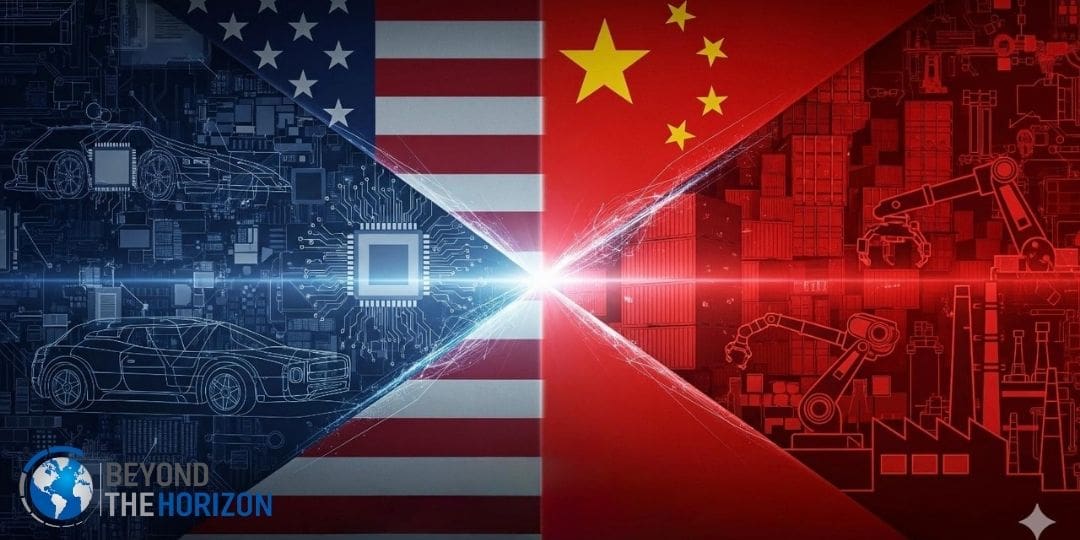Washington — In a stark escalation of its annual assessment, the U.S.-China Economic and Security Review Commission warns that Beijing has fundamentally pivoted from economic competition to active conflict preparation.
The 2025 report outlines a newly identified "China Shock 2.0," where massive state subsidies for high-tech sectors—specifically EVs, green energy, and advanced materials—are flooding global markets, crushing foreign competition, and cementing dangerous dependencies. This economic warfare now underpins a growing "Axis of Autocracy," with China acting as the decisive financial and technological enabler for Russia, Iran, and North Korea. Facing critical asymmetric U.S. vulnerabilities in pharmaceuticals, space, and energy infrastructure, the Commission concludes that the window for managing competition is closing, necessitating urgent defensive measures to decouple strategic supply chains.
"China Shock 2.0" & The Two-Speed Economy
The report identifies a core imbalance: weak domestic consumption combined with massive state subsidies for high-tech manufacturing. This creates systemic overcapacity, forcing Chinese firms to export their surplus, flooding global markets. This "China Shock 2.0" is driven by an increasing number of industrial firms operating at a loss, prioritizing market share over profit.
China's Global Trade Surplus
China's trade surplus is projected to exceed $1 trillion as exports consistently outpace imports.
Industrial Pressure
The share of Chinese industrial firms operating at a loss has nearly doubled since 2014.
The "Interlocking Innovation Flywheel"
China's "Made in China 2025" policy has successfully created an "industrial commons" where advancements in one sector rapidly catalyze breakthroughs in adjacent ones. This "flywheel" effect, shown below, allows state-backed champions to dominate entire high-tech supply chains, particularly in green energy and electric vehicles.
China's Innovation Ecosystem
A diagram representing the interconnected sectors of China's state-directed industrial policy.
Dominance in EV Battery Supply Chains
China controls the vast majority of refining and component manufacturing for EV batteries.
Graphite Refining
Lithium Refining
Anode Components
Global Impact & Weaponized Interdependence
This economic strategy is not just commercial; it's geostrategic. By becoming the sole source for key goods, Beijing gains coercive leverage. "China Shock 2.0" is deindustrializing emerging markets, while influence in the Pacific Islands grows. Concurrently, China is increasing its use of formal export controls to weaponize these dependencies.
ASEAN Trade Deficit
Southeast Asia is "ground zero," with its trade deficit with China growing rapidly.
Pacific Islands Trade Share
China's trade share in the Pacific Islands has more than doubled, eclipsing the U.S.
China's Use of Export Controls
Beijing is increasingly using export restrictions, prohibitions, and its "Unreliable Entity List."
The "Axis of Autocracy" & Security Threats
China acts as the "decisive enabler" for a revisionist axis, providing an economic lifeline and dual-use technology to Russia, Iran, and North Korea. This economic power funds rapid military modernization, preparations for a Taiwan contingency, and "gray zone" operations, such as the $5 billion+ lost by Americans to China-based scam centers.
The Revisionist Axis
China provides the economic and technological foundation that enables its partners to challenge regional stability.
-
→
China (Enabler): Provides dual-use tech, sanctions evasion, and diplomatic cover.
-
→
Russia: Receives tech for its war in Ukraine; coordinates on sanctions evasion.
-
→
Iran: Receives funding via oil purchases; shares sanctions evasion tactics.
-
→
North Korea: Receives material support and diplomatic cover for its weapons programs.
Increase in China-Russia Bilateral Trade Since 2021
Satellites Launched by China in the Last Decade
Lost by Americans to China-linked Scam Centers in 2024
Advance Warning for a Potential Taiwan Blockade or Invasion
Critical U.S. Vulnerabilities
The report concludes by highlighting several direct, asymmetric threats to U.S. national security created by these dependencies. These vulnerabilities could be exploited by Beijing to create catastrophic disruptions in a crisis.
⚠Pharmaceuticals
Extreme U.S. dependence on China for Active Pharmaceutical Ingredients (APIs) and Key Starting Materials (KSMs) creates a severe health security risk.
⚠Power Grid
Chinese-made components (transformers, energy storage) in U.S. critical infrastructure are vulnerable to cyber-sabotage by actors like "Volt Typhoon."
⚠Undersea Cables
Beijing has demonstrated a capability and willingness to sabotage critical communication cables, threatening to sever global data flows.

